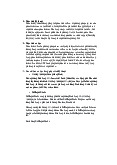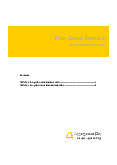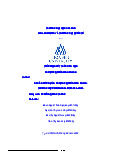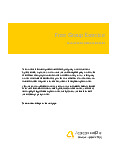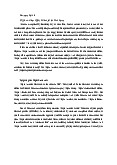



















Preview text:
MARKETING PLAN MARKETING PLAN
MCDONALD’S CORPORATION Contents
1. Company Analysis:........................................................................................1 1.1.
Brief Introduction:.............................................................................1 1.1.1.
Mission of McDonald's:......................................................1 1.1.2.
Vision of McDonald's:........................................................1 1.2.
Product analysis:...............................................................................1 1.2.1.
Hamburgers Line:...............................................................1 1.2.2.
Chickens Line:....................................................................2 1.2.3.
Porks Line:..........................................................................2 1.2.4.
Fishes Line:.........................................................................2 1.2.5.
Happy Meal:.......................................................................2 2.
Internal Analysis:...........................................................................3 2.1.
Customers Analysis:..........................................................................3 2.2.
Company Analysis:............................................................................3 2.2.1.
SWOT Analysis:.................................................................3 2.2.2.
Product Strategy:.................................................................4 2.3.
Competitors Analysis:.......................................................................4 2.3.1.
Percetual Map:....................................................................4 2.3.2.
Competitors’s analysis:.......................................................5 3.
External Analysis:..........................................................................6 3.1.
PESTEL Analysis:.............................................................................6 3.1.1.
Political Factors:.................................................................6 3.1.2.
Economic Factors:...............................................................6 i 3.1.3.
Social/Sociocultural Factors:...............................................6 3.1.4.
Technological Factors:........................................................7 3.1.5.
Ecological/Environmental Factors:.....................................7 3.1.6.
Legal Factors:......................................................................7 3.2.
Recommendations:............................................................................8 3.2.1.
Threats:...............................................................................8 3.2.2.
Opportunities:.....................................................................8 4.
Marketing Strategy:........................................................................8 4.1.
Marketing Strategy:...........................................................................8 4.1.1.
Segmentation:.....................................................................8 4.1.2.
Targeting:............................................................................9 4.1.3.
Positioning:.......................................................................10 4.1.4.
Diferentiation:...................................................................11 4.2.
Recommentations:...........................................................................11 5.
Marketing Mix:............................................................................11 5.1.
Product:...........................................................................................11 5.2.
Price:...............................................................................................13 5.2.1.
Pricing objectives:.............................................................13 5.2.2.
Package pricing:................................................................14 5.2.3.
Price psychology:..............................................................14 5.3.
Place:...............................................................................................14 5.3.1.
In which the US is the leading distributor:........................14 5.3.2.
Asian:................................................................................14 5.4.
Promotion:.......................................................................................15 ii 5.4.1.
Advertising:......................................................................15 5.4.2.
Public Relation:.................................................................16 5.4.3.
Direct Marketing:..............................................................16 6.
REFERENCES............................................................................17 iii 1. MARKETING PLAN 1. Company Analysis: 1.1. Brief Intr oduction:
McDonald's Corporation is founded in 1940 by Richard and Maurice
McDonald. However, McDonald's restaurant was bought by Ray Kroc to buy a
chain of restaurants from the McDonald brothers. Currently McDonald's is
headquartered in Chicago, USA and operated by Christopher J. Kempinski (as
of November 2019). According Annual Report of McDonald’s 2019,
McDonald's has more than 38,000 stores worldwide in more than 119 countries
and McDonald's revenue is USD 21.1 billion in the fiscal year 2019.
1.1.1. Mission of McDonald's:
Inspire women to cultivate the confidence they need to enrich their lives,
nourish their families, and fuel communities around the world (McDonald’s Corporation, 2020). 1.1.2. V ision of McDonald's:
Ignite a global community, especially women, to realize their best selves
through opportunity, enrichment, celebration, and above all else, uplifting
relationships. We are committed to accelerating profitable revenue growth for
the benefit of all our stakeholders (McDonald’s Corporation, 2020). 1.2. Pr oduct analysis:
McDonald's stores offer a uniform menu, but depending on the geographic
location the dishes on the menu will be tailored to the preferences and culture
of local consumers. McDonald's menus will normally include burgers, BigMac
sandwiches, Cheeseburger, Filet O-Fish and a few chicken dishes (like Wings,
Nuggets, ...) or salads and breakfast foods. In addition, McDonald's also offers
desserts and drinks such as McFlurry, ice cream cone, milkshake, soft drink and iv
McCafe. McDonald's products are always most concerned about taste, quality,
and especially that is the nutrition for customers. 2. Internal Analysis: 2.1. Customers Analysis:
CEO Steve Easterbrook has said that guest activity data and brand awareness
are tied together. What McDonald's is aiming for is its target audience, from the
store space to the friendliness of its employees to customers and the
development, advancement and innovation in technology. All of these have
created consumer awareness of McDonald's. 2.2. Company Analysis: 2.2.1. SWOT Analysis: 2.2.1.1. Strengths:
The first strength of McDonald's is one of the largest fast-food chains in the
world, which gives McDonald's an advantage in brand recognition. In addition,
the variety of dishes on the menu has also become an advantage of McDonald's
when it is available in many regions and serves multicultural customers. 2.2.1.2. W eaknesses:
The biggest disadvantage for McDonald's today is the growing negative
response to childhood obesity due to its high fat, carbs, salt and sugar content.
In addition, the main product of McDonald's is burgers that are gradually being
saturated in many markets, so McDonald's is facing the problem of changing
menus to suit tastes and cultural preferences. 2.2.1.3. Opportunities:
Nowadays, Mc Donald's has the opportunity to expand internationally by
manufacturing premium products, selling healthful products, developing a v
product supply chain or running a customer-centric campaign to add value.
trademark. Focus on development in underdeveloped countries or expanding
in the caffeinated beverage industry. 2.2.1.4. Threats:
The market is increasingly saturated, the competition in the market is
increasingly high. Government policy prohibits components like the MGS.
Today's customers who are gradually becoming health conscious should lean toward healthy products. 2.2.2. Prod uct Strategy:
McDonald's is actively changing their image to be healthy. At the time when
hamburgers were a great attraction, everyone was attracted and recognized by
the golden arches. Currently, McDonald's has saturated its market.
This McDonald's second major campaign promotes physical activity, which is
clearly shown on cups, bags and signs at each store. Currently, on gift bags or
water toads are no longer Big Macs, but instead are images that call for a
balanced, positive life for users (McDonald’s Corporation, 2020).
The last pillar campaign, which is making information more accessible,
McDonald's will provide clear nutrition information in the company's
packaging (McDonald’s Corporation, 2020). 2.3. Competitors Analysis: 2.3.1. Per ceptual Map: The perceptual mapping shows comparisons of fast food brands about how consumers perceive. List of fast food vi
brands including: Starbucks, Chipotle, Wendy's, Sonic, Arbys, Burger King and McDonald's.
The most important factor of consumers is price and quality, they always want
good quality but still cheap. Brands in the fast food industry are always trying
to reduce costs to meet consumer expectations. As seen in the map, McDonald's
seems to be the best option to meet the demand for price and quality of consumers. 2.3.2. Competitors’ analysis:
McDonald's currently not only faces direct competitors who are giants in the
hamburger and chicken fast food markets such as KFC, Burger King, Subway,
but also competes with competitors. Indirect competition from food restaurants
to coffee chains such as Pizza Hut, Chipotle Mexican Grill, Starbucks,... And in
Badkar's (2019) research paper also stated that competitors of McDonald's is
gradually improving its cuisine and menu pricing by mistake, reducing its
competitive advantage over diversity.
In addition, in terms of brand awareness and brand equity McDonald's seems to
outstrip its competitors. Lock, S. (2019) showed the result in his research that
McDonald’s is the most valuable food brand in the world in 2019 with an
estimated brand value of $ 130.4 billion, the closest competitor is Starbucks but
with an estimated brand value of 45, 9 billion USD. 3. External Analysis: 3.1. PESTEL Analysis:
3.1.1. Political Factors:
Government intervention can affect business operations. In which, the
government's orientation on diet and health is a threat and also a great
opportunity for McDonald's, since those who are criticized by consumers are
key products McDonald's group. However, this factor also enables McDonald's vii
to innovate its products, making the company's products more and more
suitable for consumers' tastes and eating trends. In addition, regarding
government issues, there are also public health policies that are increasingly
concerned by the government (Anaf, J., Baum, FE, Fisher, M., Harris, E., &
Friel, S., 2017), thereby creating for businesses many threats as well as new
opportunities such as using Marketing mix creates new products with health
benefits to attract consumers such as salad, low calorie fish,...
3.1.2. Economic Factors:
In developing countries, slow but steady growth in these countries has given
McDonald's opportunities to grow and increase the stability of its restaurant
business. because consumers here will tend to choose cheap products (Badkar,
M., 2019). On the other hand, the economic downturn of China has also
become a big threat to McDonald's (Ahmed, S., 2017), because the Chinese
market has contributed a large part to the revenue of the business. However,
McDonald's also has many new opportunities if it penetrates into the Asian market with high growth rate.
3.1.3. Social/Sociocultural Factors:
Customer behavior is always influenced by social trends, and from there it also
gradually affects the environment or indirectly affects the revenue of the
business. And in which the external factor that most influences is the increase
in disposable income, and the busy lifestyle in the urban environment. From
there, creating more opportunities for McDonald's to develop based on the
trend formed from the busy urban lifestyle that consumers gradually become
more accustomed to buying food faster than cooking at home. On the other
hand, cultural diversity has also become a challenge to businesses in the current
context (Coombes, R., 2004). For example, the cross-cultural aspect of
multiculturalism will create a variety of consumer preferences, making it
difficult for McDonald's to create new products. In addition, the trend of
healthy lifestyles also makes McDonald's face a major threat as consumers viii
increasingly have negative views of the health effects of its products
(Coombes, R, 2004; Anaf, J., Baum, FE, Fisher, M., Harris, E., & Friel, S.,
2017). From there, through analyzing the social aspect of this PESTEL
analysis, can see that creating healthy dishes is an opportunity to expand the
market and develop business of the corporation. 3.1.4. T echnological Factors:
The worldwide trend of automation is an opportunity for McDonald's to
improve productivity and increase revenue, but automation requires changes in
corporate management and productivity (Andrew, S., 2019). On the other hand,
based on the technological trend of increasing sales through mobile devices,
businesses can also reach customers closer when creating order and delivery
services through electrical applications (Robert, w., 2018). Overall,
McDonald's currently has a huge opportunity in its business operations in this technology aspect. 3.1.5. Ecological/Envir onmental Factors:
McDonald's Group can improve sustainability by mistaking branding and
improving business performance for businesses. On the other hand, the change
in climate change conditions also gradually becomes a threat to businesses
when there is a danger of insecurity of food supplies (Gillespie, A., 2007). In
this aspect of PESTEL analysis, it clarifies the environmental responsibility of
enterprises to society, in addition there are also risks affecting the supply chain of enterprises. 3.1.6. Legal Factors:
Increasingly stricter animal welfare regulations are also seen as a threat to
Mcdonald's, such as increasing costs in supply chains. However, it also creates
new opportunities for McDonald's in business such as providing animal welfare
(Rebecca, S., 2020), more interested in animal rights. In short, in this PESTEL
analysis there are threats that businesses need to address. ix 3.2. Recommendations: 3.2.1. Thr eats:
All recommendations to deal with McDonald's threats are primarily about
product changes towards healthy products. And the ultimate goal is to make all
of McDonald's menus healthy. This incentive is based on current consumer
trends towards healthy foods and the threats associated with government Health
regulations. Due to the multicultural threats of McDonald's customers in
international activities, McDonald's needs to tailor the menu to taste of
cultures, creating diversity in its menu. 3.2.2. Opportunities:
The biggest opportunity listed in the analysis is that McDonald's has the
opportunity to increase its market share in high-growth countries, such as
increasing the number of stores in the fast-growing regions of Asia.
McDonald's Corporation can also expand its social responsibility programs to
develop corporate opportunities in ecological trends. The ultimate goal is to
improve corporate environmental impact while simultaneously reinforcing
consumer awareness of the business. 4. Marketing Strategy: 4.1. Marketing Strategy: 4.1.1. Segmentation:
According Dudovskiy (2016) proclaims that McDonalds uses these segments and segmentation criteria: Geographic: area, density.
Demographic: stage of development, sex, the stages of family life cycle , earnings, job.
Behavioural: loyalty level, search interests, character, user rank. x
Psychological: Social class, standard of living. 4.1.2. T argeting: McDonald’s target Type of segmentation Segmentation criteria segment Area National/International Geographic Density City/Countryside Stage of development 8-45 Sex Man & Woman Bachelor Stage: young, not married and not living with parents
The stages of family Newly Married Couples: Demographic life cycle young, no have children Full Nest: youngest child six or younger Earnings Low and middle Students, workers, Job professionals Attitudinal loyalty and Loyalty level Conative loyalty Search interests Cost profit, effective time Behavioral Character Comfortable & careless Potential and frequently User rank eaters of fast food Psychographic Social class Lower, employ and xi middle class McDonald’s goals individual resigning, fighting, and founding Standard pf living under the multicultural consumer identity developed by Young & Rubican 4.1.3. Positioning:
In order to design a mixed marketing campaign that is most suitable for the
target customers of the business, product positioning is the most essential. In
recent years, McDonald's has used adaptive product positioning styles, from
which McDonald's periodically repositioned its products and services to change
products and services. in accordance with the company's target segment I (Dudovkiy, 2016). 4.1.4. Difer entiation:
The biggest difference of McDonald's for its competitors is Drive-through, one
of the services branded McDonald's. In addition, it is the design of lobby,
restroom or even Wifi. Today, McDonald's has more than 14,000 restaurants
providing free Wifi service to customers. On the other hand, McDonald's menu
items also make a difference, such as the breakfast and lunch-only dishes on
their menu (Maidenberd, M., 2020). 4.2. Recommendations:
Through these McDonald's main pillars, the company can improve healthy
product campaigns. In addition, McDonald's can further improve customer care
or technological innovation combined with price campaigns to create more xii
brand awareness and customer awareness. From there, McDonald's can create
dishes that suit the taste of Vietnamese consumers, at the same time combine
with the wrong price and promotion strategies to attract potential customers. 5. Marketing Mix: 5.1. Pr oduct:
Product categories: Shrimp Prince.
Ingredients: Shrimp, flour, salt, sugar, cream, herbs, tomatoes, cucumber, rice.
Describe: A dish made from shrimp rolled with flour and white rice and has a cream sauce layer on top.
Packaging: Paper box made of cardboard material with image display and M
letter handle (can be assembled).
Distribution location: Restaurants, kiosks, mobile apps and McDonald's websites. Main colors: red, yellow 5.2. Price:
5.2.1. Pricing objectives:
Maintain and improve market share leadership. Mixed marketing strategy.
5.2.2. Price psychology:
In terms of psychological pricing strategy, McDonald's often applies the
strategy of "selling 99", instead of rounding up product prices, sales units
always list less than 1 unit, which creates a sentiment. deceive buyers.
Therefore, this strategic element has always been taken into account and used
in mixed company marketing campaigns to encourage customers to buy more products. xiii 5.3. Place:
First, fast food has become a part of the daily life of young people in Asia
because the speed of urbanization is increasing. According to a survey of fast
food industry conducted by Nielsen Vietnam in 2010, up to 86% of consumers
consume this product in the age range of 20-35.
Last, McDonald's will not have to face too many difficulties to complete a
standard supply chain for their restaurant system in Vietnam, because local
manufacturers now have quite a lot of experience coordinating with the systems fast food before. 5.4. Pr omotion: 5.4.1. Advertising: Target Audience Current Improvement Newspaper (estimated at 25% of customers). Free 10% discount coupon. Newspaper Increase the frequency of newspaper ads by 5-6 times a month. Internet (estimated at 45% of
Internet (Advertising on customers). tools Google Ads,
Male and Female from 5 to 18 year old Advertising through people Adtima... and on influencing customers (Anh Facebook, Twitter, Tho Nguyen on YouTube Instagram). and Facebook) Billboards
have Internet (estimated at 6% of
appeared on some main customers). streets. xiv Advertising in main roads such as Dien Bien Phu, Kinh Duong Vuong, Nguyen Dinh Chieu, 3/2...) 5.4.2. Public Relation:
Besides, PR activities help promote good business through charitable activities
such as McDonald’s Global Best of Green and Ronald McDonald House. On
the occasion, give away popular items like food or drink. This will fascinate
individuals and will inspire them to stop. 5.4.3. Dir ect Marketing:
Sometimes, McDonald uses direct marketing, with partners such as corporate
customers, government and events and local parties. In 4P Marketing strategy,
McDonald always emphasized advertising as the most essential way to promote
products. Price McDonald's pricing strategy is a combination of combo prices
(prices bundling) with "psychological" prices. In combo prices, the company
will sell meals and other product packages at a certain preferential price. In the
"psychological" price, McDonald's has very affordable prices, such as $99.
Instead of rounding it up. It can be said; this is one of the most important
factors to encourage customers to buy products. xv 6. REFERENCES
Ahmed, S., 2017. China’s Footprints on the Global Economy: Remarks
delivered at the Second IMF and Federal Reserve Bank of Atlanta
Research Workshop on the Chinese Economy. U.S. Federal Reserve System.
Anaf, J., Baum, F. E., Fisher, M., Harris, E., & Friel, S., 2017. Assessing the
health impact of transnational corporations: A case study on McDonald’s
Australia. Globalization and Health, 13, 7.
Andrew, S., 2019. McDonald’s plans for greater restaurant automation with
third acquisition this year, <
https://www.foodserviceequipmentjournal.com/mcdonalds-plans-for-
greater-restaurant-automation-with-third-acquisition-this-year/ >
Badkar,M., 2019. McDonalds sales growth slows in the US, <
https://www.ft.com/content/f52f8524-f424-11e9-b018-3ef8794b17c6 >
Balaji, M., Ghosh, R., Shah, J., 2016. McDonalds: behind the golden arches, <
https://www.scribd.com/doc/11520753/Marketing-Strategies-of- McDonalds >
Brown, V., 2016. McDonald’s launch all-day breakfast across Australia, <
http://www.news.com.au/lifestyle/food/eat/mcdonalds-launch-allday-
breakfast-across-australia/news-
story/dd61284c91f12a28cfdd06bfc58771f0 >
Burger King Corporation, 2020. About us, < https://www.bk.com/about-bk >
Coombes, R., 2004. McDonald’s profits drop and Mars abandons king size
bars. BMJ : British Medical Journal, 329(7470), 820. xvi
Dudovskiy, J., 2016. McDonalds segmentation, targeting and positioning, <
http://research-methodology.net/mcdonalds-segmentation-targeting-and- positioning/ >
Gillespie, A., 2007. PESTEL analysis of the macro-environment. Foundations
of Economics. Oxford University Press.
Hsu, T., 2013, After KFC chicken scare, Yum plans to ‘stay the course in
China, < http://www.latimes.com/business/la-fi-mo-kfc-chicken-china- yum-20130205-story.html >
Iacobucci, D., 2014. Marketing management (MM4), South-Western, Cengage Learning, Mason.
KFC, 2020. What made us great is still what makes us great, < https://www.kfc.com/about >
Lock, S., 2019. Brand value of the 10 most valuable fast food brands
worldwide in 2019, < https://www.statista.com/statistics/273057/value-
of-the-most-valuable-fast-food-brands-worldwide/ >
Maidenberg, M., 2020. McDonald’s Warns Of Difficult Decisions Ahead as
Coronavirus Hurts Sales, https://www.wsj.com/articles/mcdonalds-
warns-of-difficult-decisions-ahead-as-coronavirus-hurts-sales- 11586360801
McDonald’s Corporation, 2020. 2019 Annual Report, 3, 10,
McDonald’s Corporation, 2020. About Us, <
https://www.mcdonalds.com/us/en-us/about-us.html >
McDonald’s Corporation, 2020. Company Overview, <
https://corporate.mcdonalds.com/corpmcd/investors-relations/company- profile.html > xvii
McDonalds., 2016. McDonald’s franchise strategy, <
https://sites.google.com/site/mcdonaldsfranchisestrategy/home >
Metro, 2019. “National Pizza Day: KFC and Pizza Hut team up to make a
gravy and …“ https://metro.co.uk/2019/02/09/national-pizza-day-kfc-
pizza-hut-team-make-gravy-popcorn-chicken-pizza-8489391/? ito=cbshare
Murphey, M., & Gause, R., 1974. UCF Research Guides: Industry Analysis –
PESTLE Analysis. Business Horizons, 17(5), 27-38.
Nsubuga, J., 2014. Burger King closes 89 restaurants after allegations staff
were mistreated, < http://metro.co.uk/2014/11/23/burger-king-closes-89-
restaurants-after-allegations-staff-were-mistreated-4959646/ >
Rebecca, S., 2020. Fast food giants still 'failing' on chicken welfare, says
report, < https://www.theguardian.com/environment/2020/jan/15/fast-
food-giants-still-failing-on-chicken-welfare-says-report >
Robert, W., 2018. McDonald's sees daily app usage jump 20%-40%, <
https://www.mobilemarketer.com/news/mcdonalds-sees-daily-app- usage-jump-20-40/531176/ >
The chart shows Fast Food Market Share in 2019. The Fast Food Market is
Highly Fragmented among many vendors. The leading brand in the Fast
Food Industry was McDonald's with 21.4% market share in 2018,
followed by Starbucks with 7.52% Fast Food market share, KFC with
2.82% Fast Food market share, Subway with 2.8%, Domino's Pizza with
1.57%, Pizza Hut with 1.24%, Burger King with 1.16%, Tim Hortons
with 1.09%, Chipotle with 1.02%. Get help with market research for the xviii
Fast Food market, including the source for this Fast Food Market Share chart xix
